No air conditioning. How do you live in the summer? I would just melt! One of the most common questions I’m asked, especially in July, is do I have air conditioning? How do people who live off-grid keep cool?
The answer is no, I don’t have air conditioning. However, I do have ways of dealing with the hot weather.
Often, we forget how recent technological developments penetrated our lives. Air Conditioning started becoming available to the middle class in the 1950s in the form of window units. Central air conditioning was invented in the 1970s.
I remember classrooms in Kentucky with no air conditioning. Working outside in the hot sun baling hay and then going for a cooling dip in the pond.
There are in fact many ways to keep cool in the summer during hot weather. This article will discuss some of those ways to keep cool plus some off-grid style air conditioners.
Can You Run AC on Solar or Wind?
The short answer is NO. Traditional AC draws on a lot of electricity and would overwhelm most alternative energy applications. Especially if your goal is to have a cabin in the woods or an out of the way homestead.
Central cooling units use @3500 watts for a conventionally sized home. Small window units pull anywhere from 750 – 1000 watts of energy.
An average small window unit would need about $1700 worth of solar panels dedicated just to the AC unit in summer. Plus there own batteries and inverter.
How Can Off-Grid Houses Stay Cool?
People stayed cool for hundreds of years before modern air conditioning. They used a number of the ways listed below.
It’s important to get to know your home. Its placement in relation to summer sun will make a difference on how fast or slow it heats up.
Place thermometers in various rooms and outside the home. This will help you monitor where your heat is coming from.
Some Ways of Keeping Cool Without AC:
Passive solar design – you can design your home to maximize cooling and heating. More on passive solar design below.
Use of shades – using shades to block sunny windows will help keep your home from heating up during the day.
Awnings – put awnings on windows that are getting hit by afternoon sun to keep the windows cooler.
Ventilation - Close windows during the day and open them at night
Cross Ventilation is having windows on both sides of a room in order to create a flow of air through the room.
Stack ventilation uses the temperature difference in the room to push warmer air up and out. Open the top half of your windows.
Having part of your home underground and using the earth as a bulk insulator.
Taking a siesta – ha yes, this one is my favorite. Ever wonder why people in tropical cultures take a nap during the afternoon and then stay up later when it cools down to work?
Use of fans – box fans and window fans work well on solar especially in the summer when you have lots of sunlight. They can be used to move warm air out and cool air into the home.
I have one of these fans. It will run on solar and does cool down better than a box fan. Its great for small spaces like a desk or office area.
Solar attic fan -these installed fans are great for pulling the heat the rises up and out of the home
Sleeping outside on a porch – we have a large covered back porch which is the highlight of summer gatherings. It is shaded by the house in the afternoon and my son loved to sleep out there in the summer.
Cook outside – cooking makes a lot of heat. Read my blog on our Outdoor Kitchen. This is especially helpful during canning season.
Plant deciduous trees and shrubs on the south and west side of the home. During the summer they shade the home but, in the winter, let the warming sun come through.
Summer afternoon space – we have a grove of trees near the house that is our summer cool down spot. A hammock and some lawn furniture make it a great spot to nap, play a game, work on writing, or read.
Passive Solar Design
A passive solar home is designed to maximize warmth in winter and coolness in summer. It does this by using placement and design adjustments.
A passive design uses many of the ideas we talked about above. Most people use it in the initial planning stage of their home; however you can also add many passive solar features to an existing home.
Using proper placement of windows, eves and awnings can help keep the sun from directly hitting the windows. Don’t have a lot of glass on the south side of your house or if you do have proper shading in place such as deciduous trees, an arbor or shades.
Insulation is also a big factor in preventing temperature swings. Having thick walls will help. Homes made of straw bales, rammed earth, or cob have an advantage here.
Earth as a Thermal Battery
Have you ever been in a cave? The earth stays a pretty constant temperature once you dig down ten feet.
The name thermal battery refers to the earth holding the temperature. So when you put coils below the earth and fill them with air or water you can move that temperature into the house.
The Earthship buildings use this technology. Since this style began in New Mexico a way to cool the home was imperative.
A thermal battery system is much smaller than a conventional geothermal system. Geothermal systems need an extensive area of ground excavation and are much larger.
By using tubes placed under the ground you can move cooler air up into your home.
Types of Off Grid Air Conditioners
Absorption Coolers
Absorption coolers are based on the premise that when you make hot water you cool the surrounding air in the process. Absorption coolers are an easy and inexpensive DIY project. They can also be purchased.
An absorption cooler is very much like an absorption refrigerator. If you have used a propane refrigerator its on the same philosophy. Heat is used to drive the cooling process.
Another advantage of absorption air conditioning is that iit does not use materials such as freon which is harmful to the environment. Often the liquid used in the heating process is water.
Swamp Cooler
A swamp cooler uses evaporation to cool air. Water actually absorbs heat which causes the surrounding air to cool.
Swamp coolers also called desert coolers to work best in arid areas of the country.
Author, Ame Vanorio has lived off-grid 25+ years and is the director of Fox Run Environmental Education Center.


